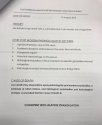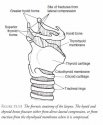Estimating the time of death
* The following is the article referred to above.
It is important to note that the estimated time of death can vary greatly from the legal time of death and the physiologic time of death. …
Unfortunately, the changes that a body undergoes after death occur in widely variable ways and with unpredictable time frames. There is no single factor that will accurately indicate the time of physiological death. It is always a best guess. …
Normal body temperature is 98.6 degrees Fahrenheit. After death, the body loses or gains heat progressively until it equilibrates with that of the surrounding medium.
As early as 1839, English physician John Davey undertook the study of corpse heat loss in London, and as late as 1962, T.K. Marshall and F.E. Hoare attempted to standardize this analysis when they established a computerized mathematical formula known as the Standard Cooling Curve. In the intervening years, and even since Marshall and Hoare, many others have attempted to devise similar schemes. Unfortunately,
none of these have proven to be any more accurate than the current formula for heat loss of 1.5 degree per hour.
The 1.5-degree-per-hour factor varies, depending upon the environment surrounding the body, the size of the corpse, clothing, and other factors. For example, a body in a temperate room will lose heat much more slowly than will one in an icy, flowing stream.
The normal 98.6 (37C) degrees Fahrenheit is an average and varies from person to person. Some people have higher normal temperatures than others. Women tend to run higher temperatures than do men.
[URL]http://www.writersdigest.com/qp7-migration-books/forensics-excerpt[/URL]
Knights Forensic Pathology says “In spite of the great volume of research and publications already mentioned, accuracy in estimating the time since death from temperature remains elusive. The old rule-of thumb was that the temperature fell at … about 1.5°F/hour, something under
1°C/hour.” and goes on to say that most of the old methods were invariably wrong, but the comments that follow this statement relate to rectal temperatures which was not used in this case.
According to his Incident Scene Report, Khan arrived at the scene at approx. 12.45am.
Susan’s body peripheries felt cool to the touch and her abdomen and chest felt warm to the touch.
Temperatures were performed between
1:00 and 1:10pm.
The temperature in the bathroom was 17.4C with no air movement.
Her internal body temperature was
30.3C.
He gave her time of death as 5:40am and took her temperature at the scene 7 1/2 hours later. We need to add 1°C x 7 1/2 = 7.5°C to her body temp. This would equate to a body temp. at time of death of 37.8C (30.3 + 7.5 = 37.8).
(Normal body temperature is 37C / 98.6F.
While Khan’s time of death may not be precise (only the killer can know the exact time if he looks at his watch), and he may not have used the old "rule of thumb" that I used above, I can't see how it can be terribly inaccurate and why Perumal is so sure his time is correct.










